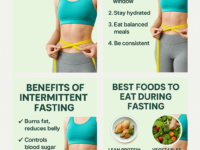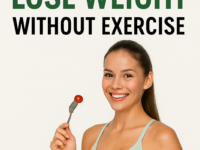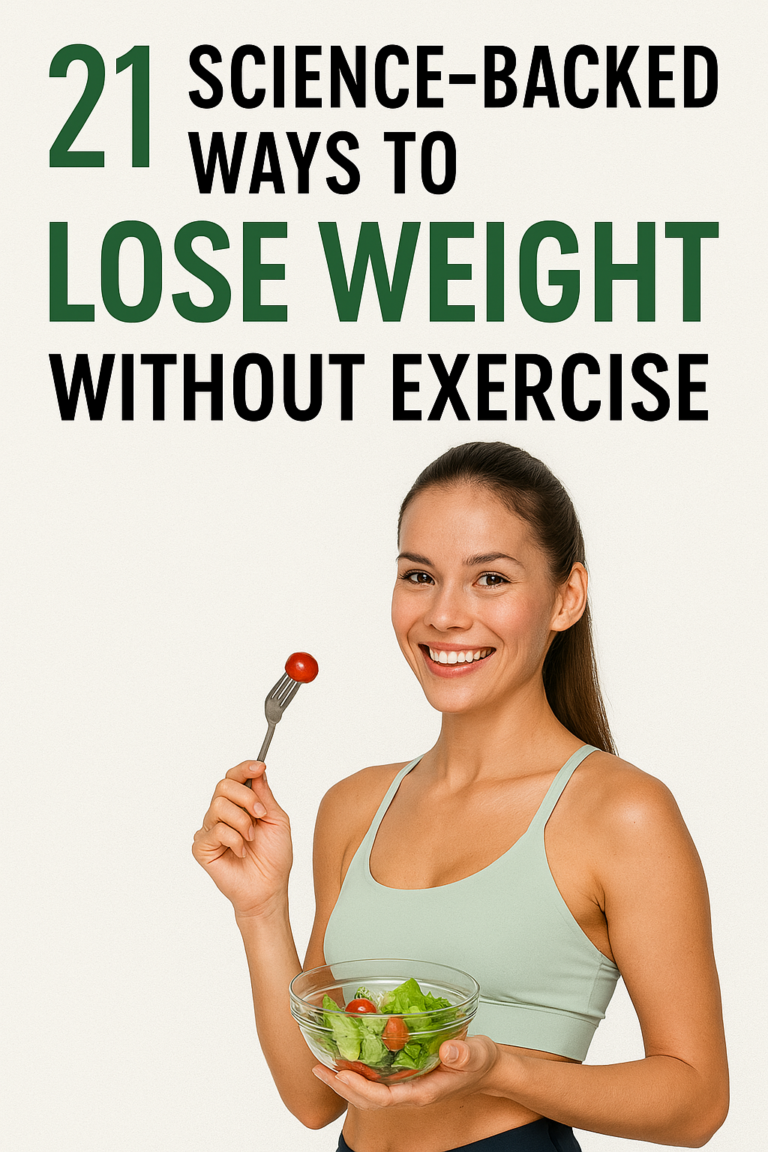Introduction: Let’s be honest — working out isn’t everyone’s favorite thing. Whether you’re too busy, dealing with an injury, or simply don’t enjoy exercising, that doesn’t mean you can’t lose weight. The good news? Weight loss is still 100% possible — even without hitting the gym. In fact, science shows that weight loss is mostly about what and how you eat, not just how many calories you burn.
In this comprehensive guide, you’ll discover 21 practical, science-backed ways to lose weight without exercise. These are beginner-friendly tips that work for real people living real lives. They’re simple, effective, and best of all — sustainable.
Let’s dive in!
- Eat More Slowly When you eat too fast, your brain doesn’t have time to catch up with your stomach. Slowing down gives your body time to recognize fullness. Studies show that slow eaters consume fewer calories and feel more satisfied.
💡 Try this: Set your utensils down between bites. Chew each bite 20–30 times. Use a timer or app to help you slow down.
- Use Smaller Plates Portion control is easier when your plate isn’t oversized. When you serve meals on smaller plates, your brain perceives more food and helps you feel full with less.
💡 Bonus Tip: Try using a plate that’s 8–9 inches in diameter.
- Drink Water Before Meals Drinking water before meals can naturally curb your appetite. One study showed that people who drank water 30 minutes before a meal lost 44% more weight.
💡 Action Tip: Drink a full glass of water before every meal. Add lemon or cucumber for flavor.
- Get More Sleep Lack of sleep leads to increased hunger hormones (ghrelin) and decreased fullness hormones (leptin). Sleep deprivation can sabotage weight loss.
💤 Target: 7–9 hours of quality sleep per night.
- Eliminate Sugary Drinks Sodas, sweet teas, and fancy coffees are loaded with hidden sugars. These beverages can contribute hundreds of empty calories daily.
🥤 Swap for: Sparkling water, unsweetened iced tea, or black coffee.
- Eat More Protein Protein boosts metabolism and helps you feel full longer. It reduces cravings and late-night snacking.
🍳 Add to your meals: Eggs, Greek yogurt, legumes, lean meats, tofu.
- Avoid Eating in Front of Screens Mindless eating leads to overconsumption. When you eat in front of the TV or your phone, you’re distracted and less aware of portion sizes.
🛑 Try this: Make meals screen-free. Focus on your food and enjoy each bite.
- Prioritize Whole Foods Whole foods are naturally lower in calories and higher in nutrients. Processed foods are engineered to make you overeat.
🍎 Eat more: Vegetables, fruits, whole grains, legumes, nuts.
- Use the Half-Plate Rule Fill half your plate with veggies before adding anything else. This naturally reduces calorie intake while increasing fiber and nutrients.
🥗 Example: Half plate veggies, quarter plate protein, quarter plate grains.
- Reduce Emotional Eating We often eat due to stress, boredom, or sadness — not hunger. Identifying emotional eating triggers is key.
💡 Coping ideas: Journaling, calling a friend, walking, listening to music.
- Keep Unhealthy Foods Out of Sight Out of sight, out of mind. You’re less likely to reach for chips or cookies if they’re not in front of you.
🏡 Tip: Store treats in opaque containers or high shelves. Keep fruits & nuts visible.
- Read Nutrition Labels Understanding what you’re eating helps you make better choices. Watch for sugar, serving size, and additives.
📖 Practice: Read labels when shopping — not just at home.
- Meal Prep & Plan Ahead When you plan meals, you’re less likely to rely on takeout or fast food. Planning helps with portion control and balanced nutrition.
📝 Weekly prep idea: Cook grains, chop veggies, and pre-portion snacks.
- Use Mindful Eating Techniques Mindful eating is all about awareness — listening to your body and eating with intention.
🍽️ Try this: Eat in silence. Focus on flavors, textures, and your fullness cues.
- Brush Your Teeth After Dinner This simple trick tells your brain that mealtime is over — and helps prevent late-night snacking.
🪥 Bonus: Fresh breath is a great deterrent against munchies.
- Limit Liquid Calories Even fruit juices and smoothies can pack a calorie punch. Always measure and track them.
🥤 Better option: Eat whole fruits instead of drinking juice.
- Don’t Skip Meals Skipping meals slows metabolism and often leads to overeating later.
⏰ Goal: Eat every 3–5 hours, even if it’s just a light snack.
- Manage Stress Chronic stress increases cortisol, a hormone that promotes belly fat.
🧘♀️ Stress busters: Meditation, nature walks, hobbies, breathing exercises.
- Add Vinegar to Your Diet Apple cider vinegar may help regulate blood sugar and increase satiety.
🥄 How to use: Mix 1–2 tsp in water before meals (check with your doctor first).
- Use a Food Journal Tracking what you eat brings awareness and accountability. You’ll identify habits you didn’t realize you had.
📓 Apps or old-school journals — both work great.
- Celebrate Non-Scale Wins Weight loss isn’t just about the number on the scale. Celebrate more energy, better sleep, clearer skin, looser clothes — they all count!
🎉 Keep going: Take progress pics, write journal entries, and share your journey.
FAQs:
Q: Can I really lose weight without exercise? A: Yes! While exercise helps, weight loss is primarily driven by calorie intake, nutrition, and habits.
Q: How much weight can I expect to lose? A: Safe weight loss is 1–2 lbs per week. Results vary by individual, but consistency wins.
Q: What’s the most important tip? A: Consistency. Small, daily actions add up over time. Choose 3–5 tips above to start today!
Final Thoughts: Losing weight without exercise is possible — and often more manageable for beginners. Focus on building habits you can sustain long-term. These tips aren’t about quick fixes; they’re about real-life strategies that fit into your daily routine.
Remember, every healthy choice counts. You’ve got this! 🙌
✅ Share this post on Pinterest or Facebook if you found it helpful. ✅ Comment below: Which tip will you try first? ✅ Bookmark this for your journey.




0 Comments